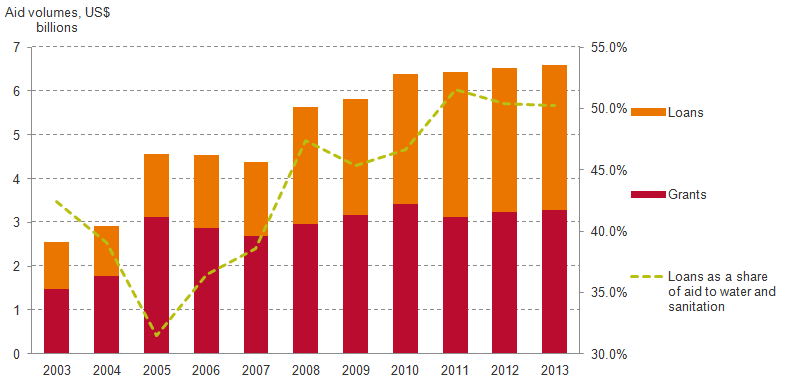Loans represent half of aid to water and sanitation
Aid to water and sanitation is increasingly delivered as concessional loans
Aid is composed of both grants and loans that meet the concessionality[1] criteria of the Organisation for Economic Co-operation and Development (OECD) Development Assistance Committee (DAC). Volumes of aid loans to water and sanitation increased steadily from US$1.1 billion in 2003 to US$3.3 billion in 2013. This is an increase of 205%, compared with a 123% increase for grants over the same period. Aid grants to the sector have remained relatively stable since 2005; US$3.1 billion in 2005 and US$3.3 billion in 2013, an increase of only US$157.5 million. Therefore, the increasing total volume of aid to water and sanitation is driven by aid loans.
The share of loans in aid to the sector has increased, from less than a third in 2005 to over half of aid since 2011. In 2013, 50.2% of aid to the water and sanitation sector came as loans and equity. This is a very large share compared with other social sectors. The health sector receives only 6% of aid as loans, and the education sector receives 14%.
Aid loans to water and sanitation go mainly to large systems projects
Between 2011 and 2013 large systems projects received on average two-thirds (64%) of all aid loans to the water and sanitation sector. [2] While bilateral donors mainly provide aid to the water and sanitation sector as grants, multilateral donors mainly provide it as loans. In 2013, more than two-thirds (68%) of multilateral aid to the sector was delivered as loans. A key driver of growth in aid to the water and sanitation sector has therefore been the increase in multilateral lending to large systems.
Download the data in Excel and CSV format
For more information see the WaterAid report 2015: Essential element: why international aid for water, sanitation and hygiene is still a critical source of finance for many countries, which is based on analysis by Development Initiatives.
For more information on aid loans, see our report ODA loans – tracking a growing source of development financing
[1] Several elements affect the level of concessionality, including interest rate, which must be lower than the prevailing market rate, and the repayment period. The levels of concessionality of different aid loans differ.
[2] ‘Large systems’ is a sub-sector of aid the water and sanitation sector. ‘Water supply – large systems’ includes: potable water treatment plants; intake works; storage; water supply pumping stations; and large scale transmission/conveyance and distribution systems. ‘Sanitation – large systems’ includes: large scale sewerage including trunk sewers and sewage pumping stations; domestic and industrial waste water treatment plants. Other sub-sectors are: waste management and disposal; basic drinking and sanitation; systems support. For more information, see www.oecd.org/investment/stats/water-relatedaid.htm
Cover photo: Catarina and her granddaughters collect unsafe water, Cuvir Rainha, Niassa, Mozambique. Credit: WaterAid/ Panos/ Adam Patterson.
Related content
Priorities for the UK’s incoming Secretary of State Alok Sharma
As Alok Sharma takes office as Secretary of State, DI's Amy Dodd sets out key priorities for the UK and its global development agenda.
From review to delivery on the Global Goals – what should the immediate priorities be for the UK government?
On 26 June, the UK government published its Voluntary National Review measuring delivery against the Global Goals - but does it accurately capture progress?
Three priorities for the High-level Political Forum 2019
DI Director of Partnerships & Engagement Carolyn Culey sets out three key priorities for closing the gap between the poorest and the rest at HLPF 2019
